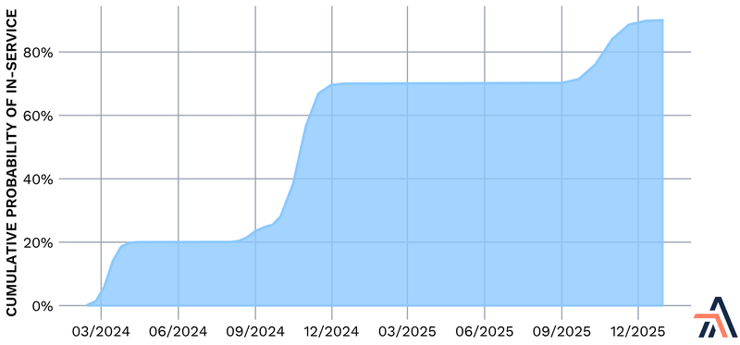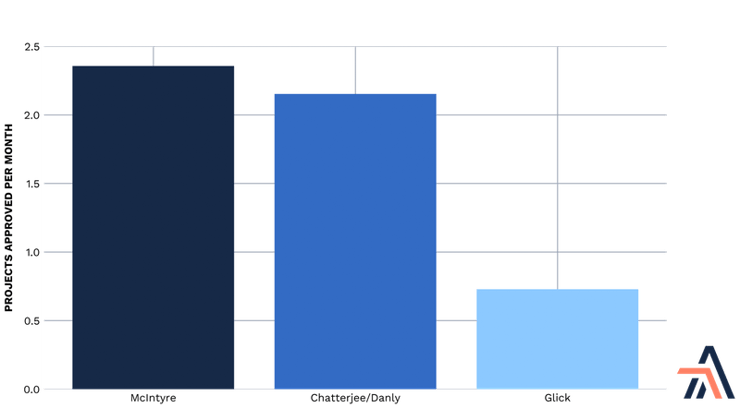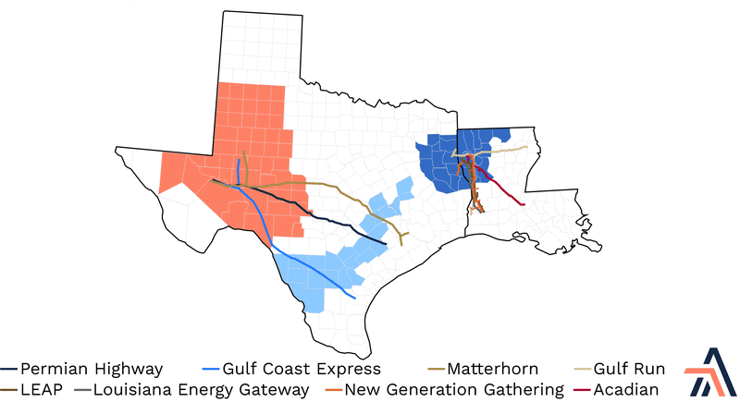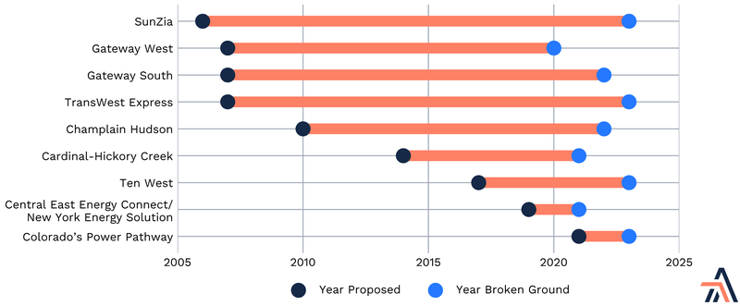Hindsight Is 2023 — A Retrospective
Originally published for customers December 13, 2023
What’s the issue?
As the year comes to a close, we always like to take a glance back at the most important events that happened in industry, and at our most popular ArView topics.
Why does it matter?
Our readership data allows us to uncover what matters most to you, our valued customers, and to plan for the year ahead.
What’s our view?
Undoubtedly, drama has been a driving force behind our readers’ content consumption, since our most read topics of 2023 revolved around the much-talked-about project MVP and the dynamic political landscape over at FERC. Additionally, your interest in gas transportation rates, the hurdles pipelines encounter in obtaining permits, and our perspectives on permitting reform have been rightfully persistent. While we anticipate similar trends in 2024, let’s leave that to a forthcoming look ahead article.
As the year comes to a close, we always like to take a glance back at the most important events that happened in the industry, and at our most popular ArView topics. Our readership data allows us to uncover what matters most to you, our valued customers, and to plan for the year ahead.
Undoubtedly, drama has been a driving force behind our readers’ content consumption, since our most read topics of 2023 revolved around the much-talked-about project MVP and the dynamic political landscape over at FERC. Additionally, your interest in gas transportation rates, the hurdles pipelines encounter in obtaining permits, and our perspectives on permitting reform have been rightfully persistent. While we anticipate similar trends in 2024, let’s leave that to a forthcoming look ahead article.
2023’s Most Valuable Player, MVP
This year's MVP award goes to none other than MVP itself — the pipeline that needed an act of Congress and an order from the Supreme Court to get back on track. The duration of this process still astounds us. (Our initial coverage of MVP dates back to July 6, 2017.) For those feeling nostalgic, we delved into MVP’s tumultuous history in MVP Finally Finds a Path to Completion. In that article, we explored MVP’s ultimate salvation, attributed largely to Senator Manchin, whose influence led to the passage of Section 324 of the Fiscal Responsibility Act of 2023. That Act, as we discuss in The Rest of This Week May Be Make or Break for MVP, directed federal agencies to issue and “continue to maintain” any outstanding authorizations for MVP and stripped the courts of judicial review authority over these approvals, directing all challenges to be heard in the DC Circuit.
However, the Fourth Circuit’s stay posed a significant setback. We appreciate everyone who joined our webcast MVP update (ArView Alert Webcast — MVP Update), engaging with us and asking insightful questions. In our heavily read follow-up, MVP Blocked Once Again by Fourth Circuit – Needs to Catch a Break to Finish, we speculated that MVP might not commence service until the end of 2025, contingent upon the speed of perfecting an appeal of the stay, as seen in the chart below. After MVP’s petition to the Supreme Court to nullify the various Fourth Circuit permit stays, we examined potential outcomes in The Rest of This Week May Be Make or Break for MVP and correctly predicted MVP’s triumph. As in our recent MVP Announces Delayed In-Service, But It May Still Be Optimistic, we are committed to monitoring the remaining buildout, and currently forecast a possible completion in the second or perhaps third quarter of 2024. But as we have told our customers who’ve asked us for regular updates on the project, the recent progress indicates that a first quarter in-service remains a possibility.

FERC Drama
Like sands through the hourglass, the past year unfolded for FERC commissioners much like a gripping soap opera. As the Days of Our Lives reference suggests, characters shifted, tensions brewed with partial dissents and concurrences, and uncertainty thickened the plot. In Chairman Glick Fades Away and Chairman Phillips Takes Over, we witnessed the conclusion of Glick’s controversial tenure, marking perhaps the worst period for pipeline projects in FERC's history, visualized below. We also documented the gradual return to a functioning Commission amidst these changes.

In Acting Chairman Phillips Appears to Be Enforcing Key Aspects of the Failed Draft Certificate Policy Statement, we highlighted Phillips’s decisions to overturn some of Chairman Glick’s choices — which we thought could hasten FERC’s review process. However, we cautioned that not all of Glick’s policies were discarded. We also noted the effect the political whipsaw has had on projects in Regional Energy Access – A Study in FERC Dysfunction Both Democrat and Republican. Furthermore, in FERC Tries to Clear Pipeline Project Backlog, but Republican Commissioner Says No, we discussed how Phillips’s efforts to return the Commission to normalcy hit a wall when Commissioner Danly voted against projects in the July open meeting. A dramatic Commission provides lots to write about, but it’s terrible for projects, so Arbo remains hopeful that some of these plot lines will run their course.
Pipeline Permitting Problems, Permitting Reform, and Protestors
Many readers tuned into Arbo on OGGN Podcast: Why We Need Regulatory Reform to Achieve Affordable, Reliable and Clean Energy, but if you didn’t get a chance, the discussion remains relevant to where we are with respect to needed permitting reform. In short, FERC isn’t the sole dramatic stage these days — a divided and dysfunctional House has failed to produce any meaningful Congressional action on fixing our nation’s permitting woes. As we discussed in Environmental Purists Test Being Realists, if we’re to achieve any kind of net zero goals, the U.S. needs significant changes in infrastructure permitting. And while environmental advocates all stress the urgency of climate change, some are recognizing that limiting solutions to only wind and solar energy while insisting on strict permitting processes will hamstring the effort. Unfortunately, Congress has yet to pass meaningful permitting reform, but we remain hopeful that pragmatism will prevail in 2024.
Permian Primacy — Texas and Louisiana Intrastate Growth and LNG Demand
Despite the permitting challenges that have significantly impeded greenfield interstate growth, the intrastate markets of Texas and Louisiana have been another story, which we first previewed in Permian Gas Takeaway Looks to Grow This Year and Next. It appears that bypassing FERC jurisdiction entirely has become a more viable route to pipeline project development.
Our expertise in data analytics means we love playing the role of detective, and we were pleased with the positive reception of our methodology for tracking these intrastate projects. For a refresher, we delved into our property records analysis in Property Records Show Permian Pipelines Moving Forward and hydrostatic testing and compressor station construction timing analytics in Updated In-Service Projection for Matterhorn Express Pipeline.
Integral to this landscape is the influence of global LNG demand, a topic we extensively covered in Serving the Coming LNG Demand and Interstate Service Opportunities for Intrastate Pipelines. We broke down the risks associated with potential pathways a pipeline could take — intrastate, interstate, compression, looping, or pipeline — and dissected DOE’s new rule limiting time extensions for approvals to export LNG. The map below shows some of the major intrastate projects in the region.

High Ratings on Rates Analytics
To kick off the year, we hosted a webcast with our friends at East Daley: Assessing Financial Impact of Rate Change Risk on Pipelines, Their Shippers and Investors. We covered a broad spectrum to create a valuable resource for our customers involved in rate proceedings or related risk assessment.
We also rolled up a summary of the rate case settlements resulting from the Tax Cuts and Jobs Act of 2017 in 2022 Rate Case Settlements and the Panhandle Eastern FERC Rate Order. Many of these settlements included provisions allowing rate revisions after a moratorium or necessitating new rate case filings at a defined future date, termed "comebacks." Another of our most read articles, Four Rate Cases Settled With Rate Reductions by the Pipelines, focused on settlements as an indicator of the current level of depreciation that other pipelines can expect, and other factors forecasting potential reduction in pipeline ROEs.
Energy Evolution, Electric Transmission, and the Interconnection Queue
Beyond the specifics of natural gas projects, we know the energy transition weighs increasingly on your mind. Our coverage this year expanded to include other forms of electric generation, electric transmission, and interconnection. We believe it’s constructive to consider the many parallels between the nation’s buildout of gas pipelines and the needed expansion of electric transmission, which we covered in one of our most read articles, Electric Transmission Projects Parallel Natural Gas Pipeline Woes. The chart below shows the long time frames from transmission project conception to construction.

Regarding generation capacity, the Arbo data engineering team looked deep into EIA data this year and sought to bring some clarity to in-service timing in this sector of industry — detailed in Energy Infrastructure Delays: The Slow Pace of Power Generator Construction in the U.S. Much like our methodology for pipelines, we've honed our ability to quantify delays in generation capacity, furnish more precise forecasts, and segment this data across various dimensions such as region, generation type, and numerous other factors. This approach has proven invaluable to our customers seeking greater certainty in the multifaceted and evolving power markets.
Next week, we'll provide our forecasts for 2024. Meanwhile, we extend our wishes for a safe and joyful holiday season to everyone.